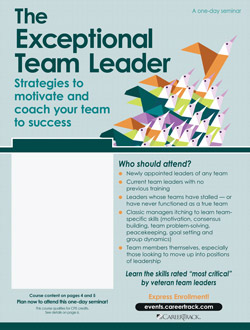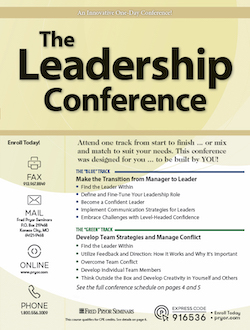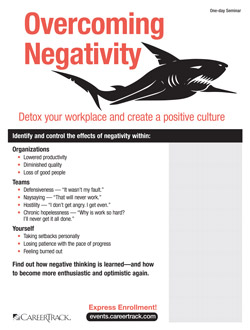How to Create a Leadership Development Program for your Business
- Author: Pryor Learning
- Categories:
- Tags:
- Share on:
The Leadership Development Factbook 2014: Benchmarks and Trends in U.S. Leadership Development, produced for Bersin by Deloitte reveals that Leadership continues to be the number one Human Capital concern for businesses[1]. As organizations struggle with leadership gaps at all management levels, the report shows businesses responding with more leadership development spending. Small companies saw the largest spending growth in leadership development initiatives (on average) – up 23% from 2013.
If you are one of those businesses seeking to “prime the pump” of leadership talent, here are some do’s and don’ts of creating an effective Leadership Development Program.
Do…
Map the Competencies That Are Needed
Design your Leadership Program so it develops the skills and talents that best serve the company that is executing it. Create a core competency map that helps employees understand what skills they need to develop to advance. It also helps managers identify candidates for training who are likely to be successful[2].
Identify the Right Candidates
A successful Leadership Development Program cherry-picks and then invests in those employees that are most likely be ready when gaps open. The method for this weeding-out process, however, varies greatly from company to company. Some aggressively promote internally and train leaders as they step up the ladder. Others take an egalitarian approach and offer training to all employees with the mindset that their “stars” will rise to the top.
However a business approaches development, it is important to continue staff development efforts even if there are no current openings. It’s too late to start development the day a gap appears[3].
Train for the Future
Create your development plan to address the future skills and needs of the business. For example, a company that plans to expand internationally may want to prepare by offering global leadership development and train employees to anticipate cultural differences in the new market.
Don’t…
Forget the End
When you take time to identify specific skills your employees need to meet specific business objectives, then you avoid the common trap of training too broadly. You also need to connect the dots and identify what success looks like so that the program can be measured. As the needs of the business changes the scope and emphasis of your development program should also change.
Restrict Learning to a Classroom
Make sure there is a real connection to the work of the business in any development program. Give employees who have been targeted as high-potential individuals the opportunity to try out their new skills. Incorporate mentor shadowing or offer opportunities to take on pilot projects that reinforce the proficiencies you want demonstrated.
Shy Away from Difficult Changes
Some problems can’t be addressed without a fundamental change of mindset. It is easy to understand the concept of delegating tasks more efficiently. However, it’s something else to correct a fundamental unwillingness to “let go” of control and hand over tasks. Developing leaders who are capable of rising to the executive level requires the hard, sometimes painful, work of unlearning bad habits and instilling new ones[4].
Forget to Enjoy the Results
The expense and time investment in creating a leadership development or succession program pays off when managers advance smoothly into more challenging leadership roles and companies avoid empty positions and overworked employees. CareerBuilder estimates that employers lose $14,000, on average, for every job that stays vacant for three months or longer[5]. Developing talent with the specific skills that your business needs means fewer vacant positions and more employees that are motivated by a work environment that offers opportunity.
[1] http://www.bersin.com/uploadedFiles/063014_WWB_LD-Factbook_KOL_Final.pdf
[2] http://www.businessdictionary.com/article/665/implementing-a-leadership-development-program-for-your-business/
[3] http://www.inc.com/guides/2010/07/how-to-create-a-leadership-development-program.html
[4] http://www.mckinsey.com/insights/leading_in_the_21st_century/why_leadership-development_programs_fail
[5] http://thehiringsite.careerbuilder.com/2014/03/06/cost-of-unfilled-positions/
Choose a Seminar and Save $10
Styles & Strategies to Supervise Effectively
1 Day
- CEU: 0.6
- CPE: 6
Team Training - Virtual or In-person

Spark Innovation and Think Strategically
1 Day
- CEU: 0.6
- CPE: 6
Team Training - Virtual or In-person

How to Manage Remote Employees
1 Day
- CEU: 0.6
- CPE: 6
- HRCI: 5.5
- PDC: 6
Team Training - Virtual or In-person
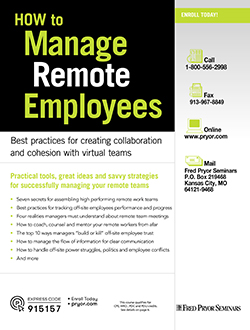
Transitioning to Supervisor
1 Day
- CEU: 0.6
- CPE: 6
Virtual Seminars:
-
Apr 17
-
Apr 18
-
Apr 22
-
+ 41 more dates
In-Person Events:
- Apr 22, Phoenix, AZ
- Apr 23, Ontario, CA
-
+ 14 more dates
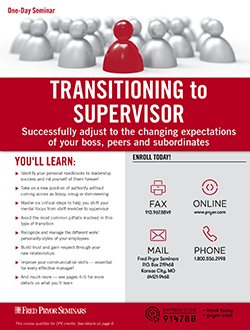
Criticism & Discipline Skills for Managers and Supervisors
1 Day
- CEU: 0.6
- CPE: 6
- HRCI: 5.5
- PDU: 6
Virtual Seminars:
-
Apr 23
-
May 6
-
May 15
-
+ 13 more dates

Management & Leadership Skills for New Managers and Supervisors (2-Day)
2 Days
- CEU: 1.2
- CPE: 12
Virtual Seminars:
-
Apr 17-18
-
Apr 22-23
-
Apr 24-25
-
+ 32 more dates
In-Person Events:
- Apr 16-17, Atlanta, GA
- Apr 29-30, Denver, CO
-
+ 21 more dates

Facilities Management - A 2-Day Comprehensive Course
2 Days
- CEU: 1.2
- CPE: 12
Virtual Seminars:
-
Apr 16-17
-
Apr 23-24
-
Apr 29-30
-
+ 25 more dates
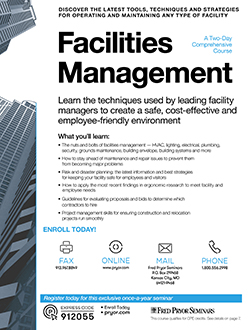
Leadership, Team-Building and Coaching Skills for Managers and Supervisors
1 Day
- CEU: 0.6
- CPE: 6
- HRCI: 5.5
- PDC: 6
- PDU: 6
Virtual Seminars:
-
Apr 16
-
Apr 17
-
Apr 18
-
+ 41 more dates
In-Person Events:
- Apr 16, San Diego, CA
- Apr 22, Indianapolis, IN
-
+ 20 more dates

Managing with Assertive Confidence
1 Day
- CEU: 0.6
- CPE: 6
Virtual Seminars:
-
Apr 16
-
Apr 22
-
May 8
-
+ 3 more dates

How to Supervise People
1 Day
- CEU: 0.6
- CPE: 6
- PDC: 6
Virtual Seminars:
-
Apr 16
-
Apr 17
-
Apr 22
-
+ 26 more dates
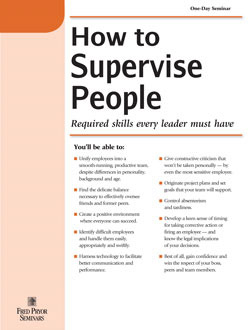
How to Supervise Bad Attitudes and Negative Behaviors
1 Day
- CEU: 0.6
- CPE: 6
- HRCI: 5.5
- PDC: 6
Virtual Seminars:
-
Apr 17
-
Apr 22
-
Apr 25
-
+ 18 more dates

How Managers Become Great Leaders
1 Day
- CEU: 0.6
- CPE: 6
Virtual Seminars:
-
Apr 17
-
Apr 18
-
Apr 23
-
+ 16 more dates
In-Person Events:
- Jul 22, Nashville, TN
- Jul 25, Las Vegas, NV

Leadership & Management Skills for Women
1 Day
- CEU: 0.6
- CPE: 6
Virtual Seminars:
-
Apr 17
-
Apr 29
-
May 7
-
+ 8 more dates
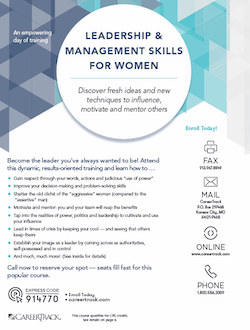
A Crash Course for the First-Time Manager or Supervisor
1 Day
- CEU: 0.6
- CPE: 6
- HRCI: 5.5
- PDC: 6
Virtual Seminars:
-
Apr 18
-
Apr 22
-
Apr 24
-
+ 27 more dates
In-Person Events:
- Jun 13, Phoenix, AZ
- Jun 18, New York, NY
-
+ 2 more dates

The Indispensable Office Manager
1 Day
- CEU: 0.6
- CPE: 6
Virtual Seminars:
-
Apr 23
-
May 1
-
May 6
-
+ 5 more dates
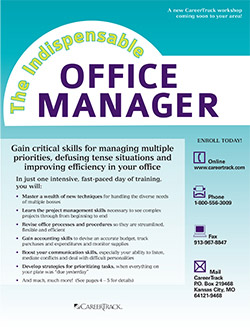
Be the Manager Your Employees Want to Follow
1 Day
- CEU: 0.6
- CPE: 6
- PDC: 6
Virtual Seminars:
-
May 5
-
May 8
-
May 14
-
+ 5 more dates
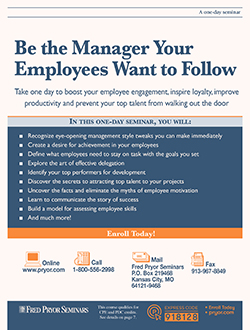
How to Improve Employee Accountability with Remote and In-Person Teams
1 Day
- CEU: 0.6
- CPE: 6
- PDU: 6
Virtual Seminars:
-
Jun 3
-
Jun 9
-
Jun 18
-
+ 5 more dates

The Exceptional Team Leader
1 Day
- CEU: 0.6
Virtual Seminars:
-
Jun 3
-
Jun 9
-
Jun 18
-
+ 5 more dates
